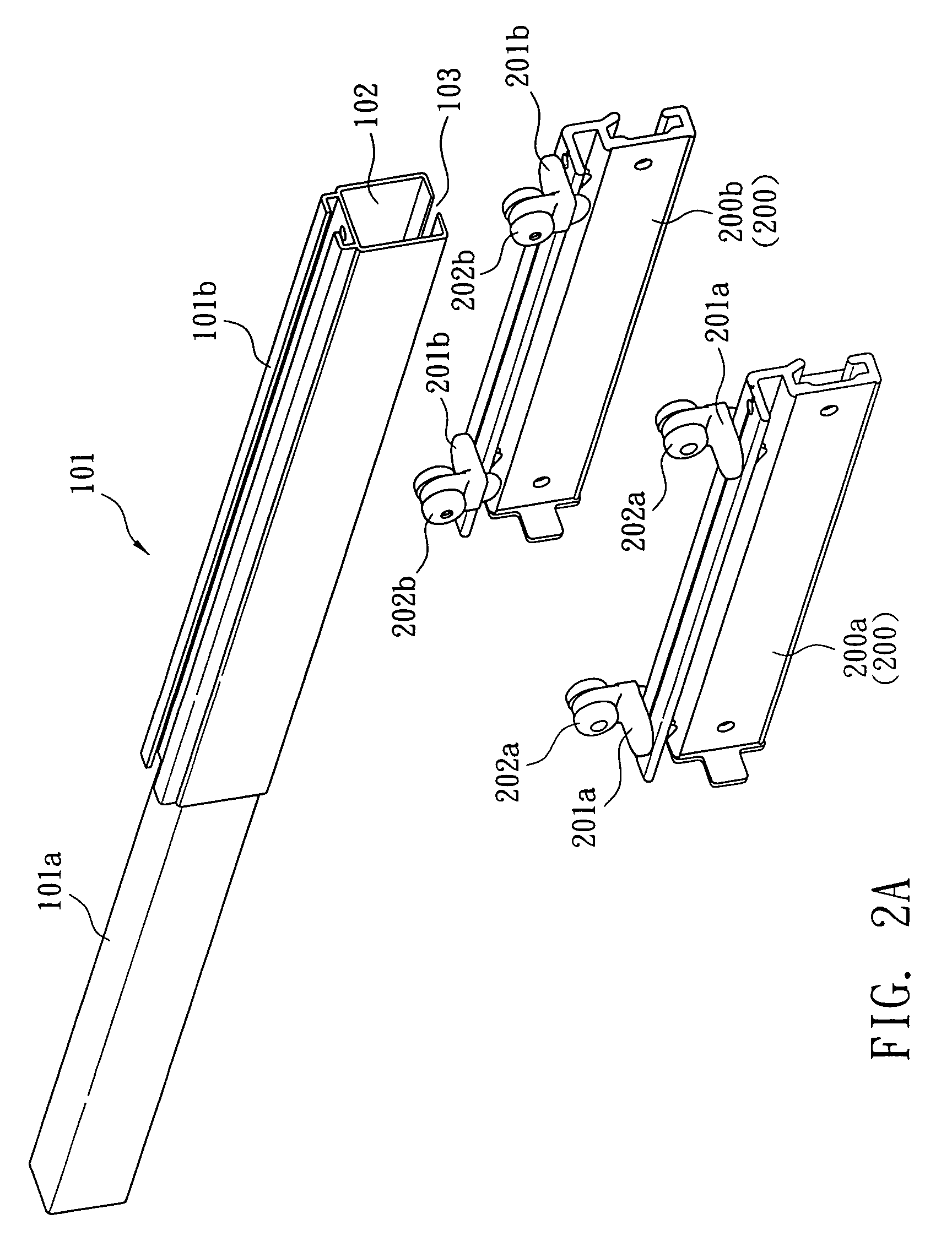Sliding panel
a sliding panel and panel technology, applied in the field of sliding panels, can solve the problems of reducing reducing requiring more material and money, so as to reduce the amount of material used for producing the rail, simplify the rail set formation, and reduce the number of channels of the rail
- Summary
- Abstract
- Description
- Claims
- Application Information
AI Technical Summary
Benefits of technology
Problems solved by technology
Method used
Image
Examples
embodiment 1
[0035]Referring to FIG. 1 to FIG. 5, where only a single channel 102 is disposed on a rail 101 while two carrier tracks 200 are arranged in parallel under the single channel 102. The rail set 100 of this embodiment is composed of a rail 101.
[0036]The two connectors 201a, 201b are disposed in opposite directions on two carrier tracks 200a, 200b of the two adjacent panels 300. The right end of the connector 201a of the left carrier track 200a inserts through the channel opening 103 of the rail 101 and connects to one runner 202a while left end of the connector 201b of the right carrier track 200b inserts through the channel opening 103 of the rail 101 and connects to one runner 202b. Thus, the right connector 201b and left connector 201a are respectively located under left and right sides under the channel opening 103 of the channel 102. Furthermore, left and right carrier tracks 200a, 200b respectively connecting with the left and right connectors 201a, 201b are disposed in parallel ...
embodiment 2
[0038]Referring to FIG. 6 to FIG. 10A, 10B, where four carrier tracks 200 are disposed in parallel under two channels 102 of the two rails 101. The rail set 100 of this embodiment includes two rails 101. This embodiment is formed by two sets of the embodiment 1. The runners 202a, 202b, of the two carrier tracks 200a, 200b are simultaneously mounted and slide inside a channel 102 of each of the two rails 101. Thus the two adjacent carrier tracks 200a, 200b slide under each of the channels 102 in parallel.
[0039]Moreover, by the driving mechanism and the positioning mechanism disposed on the sliding panel, two sets of the two carrier tracks 200a, 200b, for a total of four carrier tracks—200a, 200b, 200a, 200b move in parallel under the rail set 100 composed of two rails 101 so as to be extended or retracted, overlapping with one another.
embodiment 3
[0040]Referring to FIG. 11A to FIG. 16, where only one channel 102 is mounted on a rail 101 and there are three carrier tracks 200 arranged and sliding in parallel under the channel 102. The rail set 100 of this embodiment consists of one rail 101. The difference between this embodiment and the embodiment 1 is that a set of two adjacent carrier tracks 200a, 200b and the panels 300 thereof is replaced by a set of three adjacent carrier tracks 200a, 200c, 200b and the panels 300 thereof. The connectors 201a, 201c, 201b respectively disposed on the three carrier tracks 200a, 200c, 200b of the three adjacent panels 300 are arranged in opposite directions or at intervals. The distance between the left and right carrier tracks 200a, 200b is enlarged so as to add a middle carrier track 200c as well as a panel 300 therein. An alternating connector 201c is arranged between the two connectors 201a, 201b disposed in opposite directions. A middle part of the connector 201c of the middle carrier...
PUM
 Login to View More
Login to View More Abstract
Description
Claims
Application Information
 Login to View More
Login to View More - R&D
- Intellectual Property
- Life Sciences
- Materials
- Tech Scout
- Unparalleled Data Quality
- Higher Quality Content
- 60% Fewer Hallucinations
Browse by: Latest US Patents, China's latest patents, Technical Efficacy Thesaurus, Application Domain, Technology Topic, Popular Technical Reports.
© 2025 PatSnap. All rights reserved.Legal|Privacy policy|Modern Slavery Act Transparency Statement|Sitemap|About US| Contact US: help@patsnap.com



